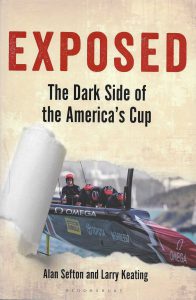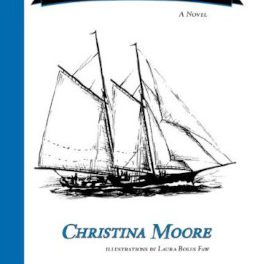 When this A-Z history of the Auld Mug landed in my lap, my first thought was: “I am so over the Cup.” Being somewhat on the fence between favoring “traditional” yachts, like the 12-Meter, designed to a developmental rule, and the current super-fast one-design foiling catamarans where execution is more critical than design and even tactics, I’ve tried to keep an open mind regarding the future of the world’s oldest sporting trophy. Opening the book to Chapter 1, “Endless Intrigue and Controversy,” and noting the authors are from New Zealand, I figured there’d be a good bashing of the New York Yacht Club, which employed various chicaneries to keep the Cup for 132 years—until the winged wonder Australia II wrested it in 1983.
When this A-Z history of the Auld Mug landed in my lap, my first thought was: “I am so over the Cup.” Being somewhat on the fence between favoring “traditional” yachts, like the 12-Meter, designed to a developmental rule, and the current super-fast one-design foiling catamarans where execution is more critical than design and even tactics, I’ve tried to keep an open mind regarding the future of the world’s oldest sporting trophy. Opening the book to Chapter 1, “Endless Intrigue and Controversy,” and noting the authors are from New Zealand, I figured there’d be a good bashing of the New York Yacht Club, which employed various chicaneries to keep the Cup for 132 years—until the winged wonder Australia II wrested it in 1983.
Then my own small though personal connection to the Cup came back to me in a wave of nostalgia. Living aboard a Pearson Vanguard in Newport harbor that year, I had a beat-up plywood quahog skiff for a water taxi, and as darkness fell on that fateful day and the Australian yacht, throngs gathered round the docks to see her lifted from the water. I was right there with two pals, touching the topsides. After much revelry and music from Men At Work, syndicate chief Alan Bond raised his hands like Moses unveiling the Ten Commandments, and Australia II lifted, water dripping from the controversial and camouflaged wing keel. We reached and touched it, as if it were as fabled as the relic tablet writ by God.
So, yeah, once upon a time I was invested in the story of the Cup. I decided to give Chapter 1 a fair chance to engage me. On page 31 my friend Barbara Lloyd, then a reporter for the New York Times, was referenced. And on the same page, there was lengthy reference to an article I’d written for Professional BoatBuilder magazine that reignited the long-standing argument as to just who designed the wing keel. While Aussies maintain the now-deceased Ben Lexcen was responsible, I’d interviewed Dutch hydrodynamicist Peter van Oossanen, who had tested the keel design at the Marin test tank in The Netherlands, and now claimed authorship.
Hooked, I kept reading, waiting for the authors’ bias to show…but it never came. Alan Sefton and Larry Keating have written a thorough, fair, and compelling history of the America’s Cup that holds interest on many levels. Actual telling of specific races, beginning in 1851, are detailed where necessary and sparing when not. Observing that people like to read about people, concise backgrounds of the many players involved over the years add human interest. For example, in 1910 British aviator Thomas Sopwith won a £4,000 prize for the longest flight from England to the Continent, 169 miles in 3 hours, 40 minutes, and used his winnings to help establish himself in airplane construction. During World War I, he built more than 16,000 aircraft, including the Sopwith Camel, which Canadian Captain AR Brown flew when he shot down “the greatest air ace of World War I, Germany’s Baron Manfred von Richthofen, ‘The Red Baron’.” Peppered with such intriguing anecdotes, Exposed ranges farther inland than those accounts of the yachting press.
The Deed of Gift, written by America’s co-owner George Schuyler, a fairly simple three-page (as reprinted in the book) document that governs Cup competition, has been tested numerous times in court, and Exposed recaptures the essence of each suit, sometimes growing tedious. But therein lies the crux of contention among challengers and defender. Skim those pages if your eyelids droop.
Politicking aside, Exposed also is a timeline of yacht classes, from the George Steers-designed America to the fabulous steel-hull J-Boats of Shamrock V and Endeavour, to the smaller but equally powerful, mostly aluminum, Twelves, and finally in the last regattas, lightweight foiling catamarans built almost entirely of carbon fiber. The last regatta was held in 2017 in Bermuda of all places, just another nose thumb at the Deed of Gift requiring races be held in the defender’s home waters; Larry Ellison’s Oracle Team USA technically belongs with the St. Francis Yacht Club in San Francisco, California.
Oh, well.
But just when you vow not to give another hoot about the Cup, you learn that New Zealand, which in Bermuda whipped Oracle good in 50-foot look-alike catamarans, vowed a return to the Deed’s promise of “friendly competition between foreign countries.” Commercial sponsorship has radically, and probably forever, changed yacht racing. While not showing their hand in the multihull vs. monohull debate, the Kiwis have promised to do two things of significance: require that the yachts be built in the country they represent, and their crew residents of same. In that return to tradition, it seems just that the Americans lost in Bermuda, with but one part-time crew hailing from the U.S. Most of the others —10—were Australians. (Update: the Kiwis have chosen a foiling monohull design. – Eds.)
Much has been made of the high cost to mount an America’s Cup campaign, which led to commercialization and smaller one-design yachts. But as more than one observer has noted, the Cup has always been about larger-than-life billionaires and their big magnificent yachts. The public is fascinated with owners such as Harold Vanderbilt, J Pierpont Morgan, and Ted Turner, many of whom were also their own skippers. And those of us who love sailboats are intrigued with designers like Edward Burgess, Charles Nicholson, and Olin Stephens. Unfortunately, the latter are given little space in this book, as well as the science of making hulls go fast, which used to be integral to any story about the Cup. History help us if by some legal wrangling the end story is a robotic boat designed by a committee of computer nerds, owned by a software company, and skippered from land with a joy stick.
Exposed, The Dark Side of the America’s Cup, by Alan Sefton and Larry Keating (Adlard Coles, 2017; 304 pages)





